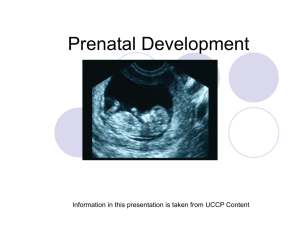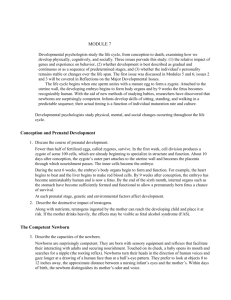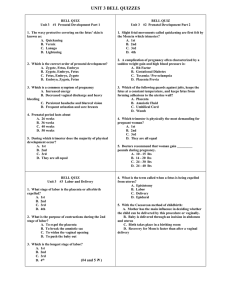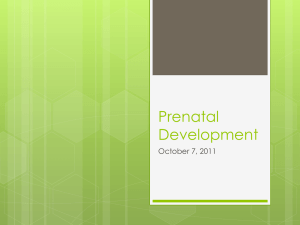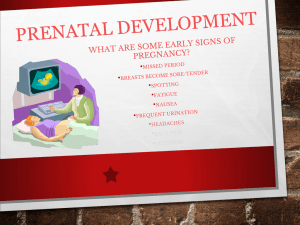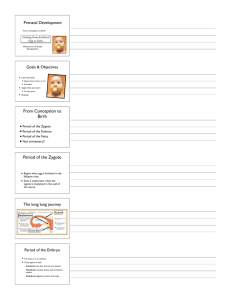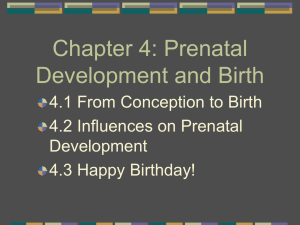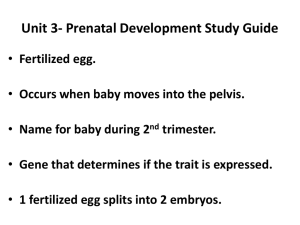Conception and Birth PowerPoint Presentation
advertisement
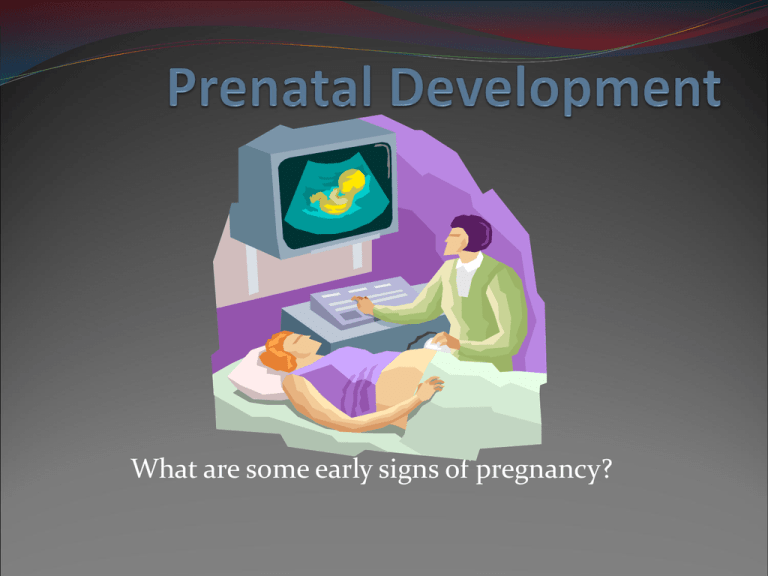
What are some early signs of pregnancy? From Conception to Birth Period of the Zygote Period of the Embryo Period of the Fetus Period of the Zygote Begins when egg is fertilized in the fallopian tube. Period of rapid cell division Ends 2 weeks later when the zygote is implanted in the wall of the uterus Period of the Zygote Period of the Embryo From 3 to 8 weeks after conception Body parts are formed during this period Embryo rests in the amnion filled with amniotic fluid Umbilical cord joins embryo to placenta Prenatal Structures Period of the Fetus From 9 weeks after conception to birth Increase in size and systems begin to function Age of viability: 22 to 28 weeks First Month By the end of the first month, the embryo is about 1/10 of an inch long. The heart, which is no larger than a poppy seed, has begun beating. First Month Two Months The embryo is about 1 inch long and has distinct, slightly webbed fingers. Veins are clearly visible. The heart has divided into right and left chambers. Two Months Three Months By now the fetus is 2 1/2 to 3 inches long and is fully formed. He has begun swallowing and kicking. All organs and muscles have formed and are beginning to function. Four Months Your baby is covered with a layer of thick, downy hair called lanugo. His heartbeat can be heard clearly. This is when you may feel your baby's first kick. 4 months Five Months A protective coating called vernix caseosa begins to form on baby's skin. By the end of this month, your baby will be nearly 8 inches long and weigh almost a pound. Six Months Eyebrows and eyelids are visible. Your baby's lungs are filled with amniotic fluid, and he has started breathing motions. If you talk or sing, he can hear you. 6 Months Seven Months By the end of the seventh month, your baby weighs about 3 1/2 pounds and is about 12 inches long. His body is well-formed. Fingernails cover his fingertips Eight Months Your baby is gaining about half a pound per week, and layers of fat are piling on. He has probably turned head-down in preparation for birth. He weighs between 4 and 6 pounds. Nine Months Your baby is a hefty 6 to 9 pounds and measures between 19 and 22 inches. As he becomes more crowded, you may feel him move around less. Influences on Prenatal Development General Risk Factors Teratogens: Diseases, Drugs, and Environmental Hazards How Teratogens Influence Prenatal Development Prenatal Diagnosis and Treatment General Risk Factors Nutrition: adequate amount of food, protein, vitamins, & minerals Stress: decreases oxygen to fetus and weakens mother’s immune system Mother’s Age: neither too young, nor too old Teratogens: Diseases, Drugs, and Environmental Hazards • Many diseases pass through the placenta directly and attack the fetus • Potentially dangerous drugs not limited to cocaine but include alcohol and caffeine • Environmental hazards are treacherous because we’re often unaware of their presence How Teratogens Influence Prenatal Development Not universally harmful Harm particular structures at a particular point in development in particular animals Effects of Teratogens Prenatal Diagnosis and Treatment Diagnosis: ultrasound, amniocentesis, and chorionic villus sampling can detect physical deformities and genetic disorders Treatment: fetal medicine and genetic engineering are experimental Prenatal Diagnosis Amniocentesis Chorionic Villus Sampling Labor and Delivery Stage 1: starts when the muscles of the uterus contract and ends when the cervix is fully enlarged (about 10 cm) Stage 2: baby is pushed down the birth canal Stage 3: placenta is expelled Three Stages of Labor Approaches to Childbirth • Childbirth classes provide information about pregnancy and childbirth • Childbirth classes teach pain control through deep breathing, imagery, and supportive coaching • Mothers who attend classes use less medication during labor and feel more positive about labor and birth Birth Complications • Lack of oxygen (anoxia): Often leads to surgical removal of the fetus (C-section) • Premature and Small-for-date infants • Prematurity is less serious than smallfor-date The Newborn • Assessing the newborn: Apgar to assess newborns’ health; NBAS for a comprehensive assessment of infants • 4 primary states: alert inactivity, waking activity, crying, sleeping • Half of newborns’ sleep is REM (deep sleep) • Putting the baby to sleep on their back may prevent SIDS Postpartum Depression Half of all new moms feel some irritation, resentment, and crying 10-15% feel more severe postpartum depression Postpartum depression affects warmth and enthusiasm of mothering Happy Birthday!!!
